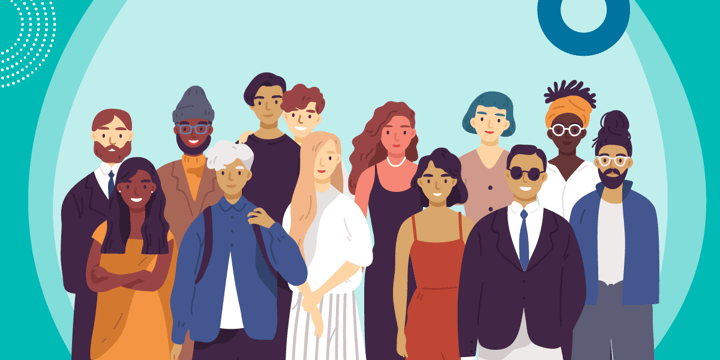We all know that racial diversity is important within the nonprofit sector, but it can often feel difficult to know where to start and how to make improvements at your organization. This is a topic especially on the forefront of many people's minds as we enter Black History Month this year.
We at TechSoup have been thinking a lot about race equity within our own organization. If you, too, have been wondering how best to integrate race equity into your workplace, Equity in the Center, an organization that "works to shift mindsets, practices, and systems within the social sector to increase race equity," has released a very helpful guide. It is titled Awake to Woke to Work: Building a Race Equity Culture (PDF), and it provides great pointers for where and how to start. What follows is a brief overview of the guide itself. We encourage you to read the guide and share these ideas across your organization this month and beyond.

The Need for Race Equity Work in Nonprofits
Nonprofits have a vested interest in integrating race equity into their work, especially those that serve racially diverse groups. In this guide, race equity is defined as "the condition where one's racial identity has no influence on how one fares in society."
The nonprofit sector is currently far from reaching such race equity. For example, a 2017 report found that only 10 percent of CEO. positions at nonprofits are held by people of color. This is just one of many examples why it is important for members of the nonprofit workforce to fight against racial inequality within their own organizations.
Race Equity Cycle
Before beginning your race equity work, it is important to take a complete and honest look at your organization to determine where you currently fall along the cycle and where you would like to go.
Awake
The Awake stage is the first step in the race equity cycle. Organizations at this stage are focused on building a racially diverse workforce. The driving goal here is representation. It requires paying attention to diversity and making room for diverse backgrounds.
Woke
The Woke stage comes after the Awake stage. At this stage, organizations are focused on creating a space in which everyone is able to speak about their experiences and be heard. Here, the principal goal is inclusion. This often demands internal changes.
Work
The final stage of the race equity cycle is the Work stage. When organizations have reached this level, they are concerned with ameliorating systems around race equity. The goal, beyond representation and inclusion, is integration. This requires adopting an active race equity lens and mindset.
Levers for Change
The guide presents seven levers that any organization may have at its disposal to move through the race equity cycle. Each organization should determine which of these levers is its strongest strategic element and consider how it can be used. Each lever can change the organization's personal beliefs and behaviors, its policies and processes, or its data collection to reach a race equity goal.
Senior Leaders
Senior leadership plays a big role in creating change. They can encourage an environment in which different life experiences are valued, encourage discussion of issues about diversity, and be models for employees.
Managers
Managers who oversee teams also have a lot of power to exercise. Managers should be aware of diversity when hiring and building teams. It is important for managers to ensure that people of color are supported and have opportunities for promotions and professional development.
Board of Directors
Your board of directors can do a lot to guide an organization along its race equity cycle. For example, the board of directors can choose to "track retention and promotion rates by race" and can "make racial equity a performance issue during their team's annual review."
Community
The population served by the organization should not be overlooked as a lever for change. Seeking community input and feedback on programs is an important way to ensure that the community is involved. Talking openly with the community you serve about diversity can support your efforts and ensure that your work is successful.
Learning Environment
The learning environment for your staff is an often overlooked piece of the puzzle. Focusing on your staff's knowledge about racism and biases is a good place to start. Making room for critical discussions, in which those from minority and majority groups learn from one another, is a needed next step.
Data
Data is both a tool at the disposal of each lever and a lever in itself. Tracking data about race and diversity is essential to measuring your organization's progress along the race equity cycle. Thinking creatively about how to collect and track this data is important, too.
Organizational Culture
Lastly, the organizational culture at your workplace is a central lever. Shifting the shared values, assumptions, and beliefs held by your team is core to advancing along the race equity cycle.
Each of these levers can be used in a variety of ways, depending on where organization is along the race equity cycle. Focusing on the strongest levers first can help bring about effective change. More details and examples about how to use each lever at your disposal can be found in the Equity in the Center guide.
Conclusion
The Awake to Woke to Work: Building a Race Equity Culture guide by Equity in the Center offers an important reminder of the value of race equity within the nonprofit sector. It presents several tangible steps for reframing the issue within your organization and working to move towards greater equity. Doing so can make your organization's work more effective and impactful. While racial equity is a good place to start, there are various forms of diversity that your organization could celebrate within the workplace and in your work.
Additional Resources
- Watch the webinar 5 Tips to Successfully Launch a Diversity Initiative at Your Nonprofit.
- The MSW@USC Diversity Toolkit: A Guide to Discussing Identity, Power and Privilege
- Race and Inclusion Action Guide, The Annie E. Casey Foundation (PDF)
- Holding the Mirror up to Ourselves: Diversity and Inclusion Practices and Trends in Civil Society Organisation (PDF)






